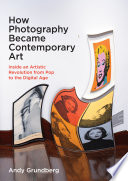2018 School Spending Survey Report
How Photography Became Contemporary Art: Inside an Artistic Revolution from Pop to the Digital Age
COPY ISBN
VERDICT A must-read for photography enthusiasts; Grundberg’s personal recollections will also appeal to readers interested in the late 20th-century New York art scene. This is an important text on the history of photography.
RELATED
ALREADY A SUBSCRIBER? LOG IN
We are currently offering this content for free. Sign up now to activate your personal profile, where you can save articles for future viewing




Comment Policy:
Comment should not be empty !!!